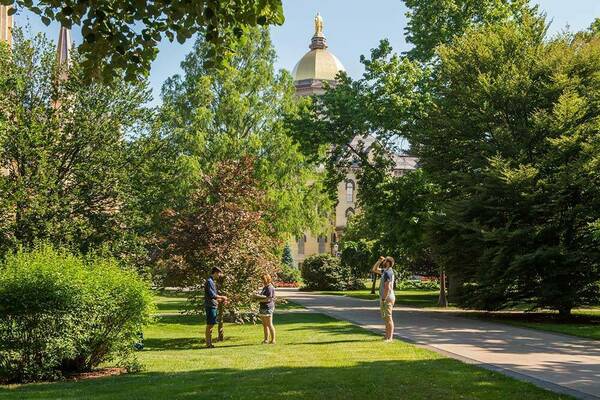
The Northern Pin Oak, also called a Jack Oak, near Stepan Chemistry Hall at the University of Notre Dame, isn’t the largest or fullest tree on campus by any stretch. However, it has been awarded the honor of being St. Joseph County’s biggest tree of its kind.

The tree holds the state record, as well, mostly because it’s on the very southern edge of its natural range, and is very uncommon in Indiana, according to Barbara Hellenthal, associate professor of the practice in the Department of Biological Sciences and curator of the Museum of Biodiversity and Greene-Nieuwland Herbarium.
The oak is one of 22 champion trees on Notre Dame’s campus, out of 40 trees from throughout the county that were recently honored through the St. Joseph County Parks Big Tree program that began in 1996.
“It is easy to take the campus trees for granted,” Hellenthal said. “This program highlights some of the special ones in a way that can be enjoyed by visitors.”
Evie Kirkwood, director of St. Joseph County Parks, developed the program after her mother, a newspaper editor in central New York, created a feature for residents to nominate interesting or special trees. Then, a reporter would write a story about them.
“I thought that perhaps a recognition program for the largest native trees in St. Joseph County would help people recognize the value of those species and give the owners and nominators a sense of pride,” she said.
During the mid-1990s, Kirkwood enlisted Hellenthal’s help to put together a list of tree species designated as native to St. Joseph County. During the early years, the parks department coordinated the program every two years, but later changed the frequency to every five years to align with the Indiana Big Tree program.
Despite having “Big Tree” in their titles, the county and state programs are not connected, Kirkwood said.
The champion trees are determined through a point index for each tree: the circumference in inches, plus the height in feet, plus one-fourth of the average crown spread in feet.
Amal Farrough, interpretive naturalist for St. Joseph County Parks who has organized the past two contests, said she enjoys the opportunity to see how many people love their trees. “I’ve read about a phenomenon called ‘plant blindness’ where people just don’t see or are not aware of plants and trees, and this program reassures me that there are many people who really do see and value them.”
Notre Dame certainly does. Hellenthal is developing a second book on the trees, shrubs and vines on campus. Her first book was published in 1993. The University spearheaded a campus-wide tree survey, headed by Hellenthal, that is ongoing.
Other winning trees on Notre Dame’s campus include an American elm near Zahm Hall, a slippery elm near Carrol Hall, two different types of hickory trees, two other oak varieties, and many other tree species.
The county’s largest basswood is found on the Warren Golf Course, which also holds many other large trees and runners-up. In the broad, open space of the golf course, trees can grow to their full potential without competition from traffic and construction projects, Hellenthal said.
The campus offers more challenges to trees of all sizes. The Northern pin oak near Stepan Chemistry Hall, for example, might consider itself a little lucky. Oak trees do not tolerate soil compaction, like that caused by foot traffic, and the tree grows at a pedestrian hub. A few years ago it began showing signs of stress. The sidewalks, shrub hedge and benches that now surround it act as a barrier that protects its roots from damage, Hellenthal said.
Nominations for the next Big Tree contest will begin in 2024, with the winners announced in 2025.
“Seeing the submitted photos of trees with family members around them gives you a sense of how passionate people are about their trees,” Kirkwood said. “In one case, owners of an oak tree were able to have a bike and pedestrian path shifted, preventing the tree’s removal, after they showed their champion’s certificate to local planners.”
Hellenthal said she’s certain that Notre Dame will apply to defend its tree titles again in five years, and perhaps enter trees in categories that had no entries this year.
“This contest is a great way to showcase the native trees we have on campus. Many species of trees grow much too large for us to plant in our own urban or suburban lawns,” she said. “The campus has the space for these big trees, and gives us the opportunity to see them growing at their best.”